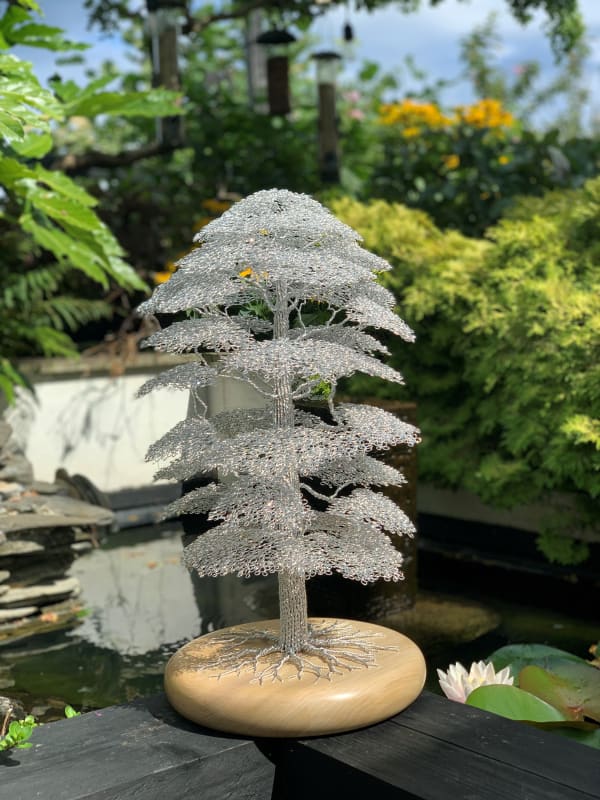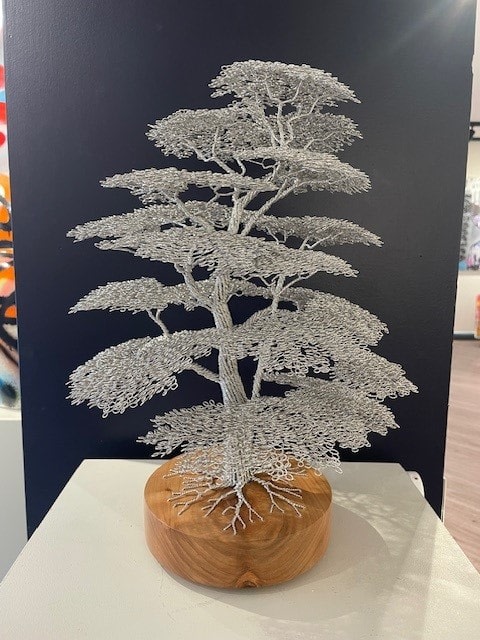Clive Maddison
Artworks
Overview
The inspiration for my wire tree sculptures came at a paper cutting artist’s exhibition at the Devon Guild of Craftsmen in Bovey Tracey, South Devon. What the artist had made in paper, I thought I could make in wire. Once I had made a couple of trees, I was asked to create a sculpture for a Christmas present. Another request was made not long after and that encouraged me to contact a gallery. I regularly holiday in the Lake District and knew of the Lee Chapman Gallery in Keswick where I had recently visited. They immediately ordered eight trees, two of which sold within two weeks.
Some time later I posted some pictures of my tree sculptures on an art website. One morning there were numerous messages congratulating me on my art which had, unbeknown to me, been featured on the main page. Following that I was contacted by a number of galleries wanting to display my work. I also received many requests from people, across the globe, enquiring about commissioning a sculpture. I started making wire trees for my own enjoyment and it has turned into something much more. I still enjoy making them as much as ever and take great pleasure knowing each piece is unique and individual.
Some time later I posted some pictures of my tree sculptures on an art website. One morning there were numerous messages congratulating me on my art which had, unbeknown to me, been featured on the main page. Following that I was contacted by a number of galleries wanting to display my work. I also received many requests from people, across the globe, enquiring about commissioning a sculpture. I started making wire trees for my own enjoyment and it has turned into something much more. I still enjoy making them as much as ever and take great pleasure knowing each piece is unique and individual.
Biography
For as long as I can remember I've had a relationship with trees. Most of us wouldn't notice how much of an impact trees have on our daily lives. It's something I have become acutely aware of in recent years following the start of my creative journey with wire tree sculptures.
Looking back, my first distinct memory of trees will probably be the same as many of you; climbing and playing in them as a young child. I was born, and grew up, in Edwinstowe; in the county of Nottinghamshire and can claim that I used to play in the Major Oak of Sherwood Forest. It has since been protected, held up by scaffolding and fenced around to prevent public access from compacting the ground around the roots. Legend has it that, the Major Oak was the hiding place of the medieval hero Robin Hood as he evaded the authorities. It currently has a circumference of 10 metres at the base, it boasts a canopy of 28 metres and is thought to be 800, perhaps even 1000 years old.
A landscape without trees can look barren, empty and desolate. The very presence of mature trees suggests a well established, even ancient, place. The magnificent old castles and houses of the United Kingdom are, almost without exception, accompanied by equally magnificent trees that almost verify the authenticity of the building's age. Mankind can mimic the perception of age by skilful building but a monumental tree suggests the process of time has been at work. Even the fastest growing trees need time to look mature. Some trees, such as the Major Oak, need many lifetimes before children can play in the shaded areas beneath the canopy.
History records show that when invading armies conquered lands the devastation was sometimes wrought on the landscape by the felling of trees, it left a scar that reminded locals of their situation and subjugation, for many years to come. Then, very slowly over time, nature would reclaim the damaged terrain, repairing, rejuvenating and regrowing, so the generations that followed could barely conceive of the destruction that took place. Trees give a sense of history, an image of permanence and an indication of life, visible and hidden, in the landscape. They give texture to the scenery and when you walk in the wooded areas, they wrap you in a leafy blanket of nature that never fails to impress those who take a moment to notice what has taken years to perfect. They are nature's clock that signals the seasons with new life in spring, fullness in summer, colour and fruit in autumn and bare structure in winter.
The impressive, inspiring beauty of a mature structured tree is strived for in the ancient art of bonsai, seeking to model these gigantic plants in miniature. I have long been facinated by the curating of a mature tree in miniature form and grew several bonsai trees myself not too long ago.
The variety and beauty of trees has become the sole inspiration shaping my creative craft. Many mutations are produced by environmental influences on the same species of tree whether from prevailing winds, deep valleys, significant rainfall or heat from the sun. These forces control and shape the trees as they grow and mature into living monuments. Their ability to endure the tests of time and how they shape our environment is without doubt one of the most magnificent elements of our world. The majesty of trees will always serve to inspire myself both personally and creatively. I always aim to capture the splendour of nature. To represent the perfect imperfection of a tree. When I complete each sculpture I am urged to create another to try to mimic the beauty I see.
Looking back, my first distinct memory of trees will probably be the same as many of you; climbing and playing in them as a young child. I was born, and grew up, in Edwinstowe; in the county of Nottinghamshire and can claim that I used to play in the Major Oak of Sherwood Forest. It has since been protected, held up by scaffolding and fenced around to prevent public access from compacting the ground around the roots. Legend has it that, the Major Oak was the hiding place of the medieval hero Robin Hood as he evaded the authorities. It currently has a circumference of 10 metres at the base, it boasts a canopy of 28 metres and is thought to be 800, perhaps even 1000 years old.
A landscape without trees can look barren, empty and desolate. The very presence of mature trees suggests a well established, even ancient, place. The magnificent old castles and houses of the United Kingdom are, almost without exception, accompanied by equally magnificent trees that almost verify the authenticity of the building's age. Mankind can mimic the perception of age by skilful building but a monumental tree suggests the process of time has been at work. Even the fastest growing trees need time to look mature. Some trees, such as the Major Oak, need many lifetimes before children can play in the shaded areas beneath the canopy.
History records show that when invading armies conquered lands the devastation was sometimes wrought on the landscape by the felling of trees, it left a scar that reminded locals of their situation and subjugation, for many years to come. Then, very slowly over time, nature would reclaim the damaged terrain, repairing, rejuvenating and regrowing, so the generations that followed could barely conceive of the destruction that took place. Trees give a sense of history, an image of permanence and an indication of life, visible and hidden, in the landscape. They give texture to the scenery and when you walk in the wooded areas, they wrap you in a leafy blanket of nature that never fails to impress those who take a moment to notice what has taken years to perfect. They are nature's clock that signals the seasons with new life in spring, fullness in summer, colour and fruit in autumn and bare structure in winter.
The impressive, inspiring beauty of a mature structured tree is strived for in the ancient art of bonsai, seeking to model these gigantic plants in miniature. I have long been facinated by the curating of a mature tree in miniature form and grew several bonsai trees myself not too long ago.
The variety and beauty of trees has become the sole inspiration shaping my creative craft. Many mutations are produced by environmental influences on the same species of tree whether from prevailing winds, deep valleys, significant rainfall or heat from the sun. These forces control and shape the trees as they grow and mature into living monuments. Their ability to endure the tests of time and how they shape our environment is without doubt one of the most magnificent elements of our world. The majesty of trees will always serve to inspire myself both personally and creatively. I always aim to capture the splendour of nature. To represent the perfect imperfection of a tree. When I complete each sculpture I am urged to create another to try to mimic the beauty I see.
Store
FROM OUR GALLERY WALLS TO YOUR INBOX
* denotes required fields
We will process the personal data you have supplied in accordance with our privacy policy (available on request). You can unsubscribe or change your preferences at any time by clicking the link in our emails.









